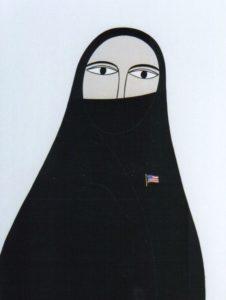Helen Zughaib came to her longtime home in Washington, D.C., by way of many other nations. Born in Beirut, Lebanon, she also lived in Iraq, Kuwait, Greece and France, before coming to the United States to earn her BFA at Syracuse University in 1981. That intricate itinerary brought with it lessons about what it means to live and work as an Arab American artist in the U.S. Zughaib began her series of paintings, “Changing Perceptions,” after the wars in Afghanistan and Iraq began, hoping to bring together the abaya—the loose overgarment worn by many Muslim women— with iconic Western artists like Picasso and Kahlo. Although Zughaib was raised in the Orthodox Christian tradition, she watched as the abaya was used as a symbol of “negativity and oppression” after 9/11 and the wars that followed. In her work, she sought to synthesize images of East and West into new representations that could provoke discussion of the abaya and Arab Americans.
Although she didn’t set out to create a series addressing Islamophobia, she says, “It ended up speaking to that issue” as negative media representations of Arabs and Arab Americans persisted. While she was working on the series, President Obama was running for office, and was frequently labeled a Muslim and criticized for not wearing a flag pin—as though those things made him “somehow less patriotic than other candidates.”
Zughaib created “Abaya with Flag Pin” as a rejoinder: a way of saying that “Arab Americans are just as patriotic and grateful to be in this country.” Zughaib’s recent work has included paintings and mixed-media fabric pieces related to the Arab Spring—both its hopes and disappointments—as well as a more personal series, “Stories My Father Told Me,” with themes drawn from her father’s childhood in Lebanon and Syria. “I think that many artists are activists in some way or another,” Zughaib says. “They reflect their times, their environment, visually recording what happens around them. The work that becomes important has its finger on the critical issues of the day. …I feel my message is more able to be heard if my painting is lovely to look at. Even though my message may be quite devastating, at least I have come close to opening up a point of view, creating that dialogue that can possibly result in mutual understanding, or at least inching towards that goal.”

